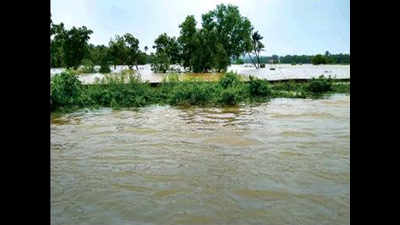Trending
This story is from August 12, 2019
Goa’s worst floods after Maharashtra opened nearly-full Tillari dam
The recent floods in North Goa, one of the worst in over two decades, was due to release of surplus water from the Tillari dam by Maharashtra as it had reached its maximum capacity.

Zonal agricultural officers have started the initial inspection of fields
KERI/PANAJI: The recent floods in North Goa, one of the worst in over two decades, was due to release of surplus water from the Tillari dam by Maharashtra as it had reached its maximum capacity.
The continuous rain, beginning early August, in the upper and lower catchment areas of the Tillari dam saw the reservoir level reach 112m. With a storage capacity of 113.2m, the water resources department of Maharashtra had but no choice to release the surplus water, sources said.
“Until last year, the quantity of water released was far lesser to cause any submergence of villages in Goa. The situation occurred this time because of the heavy rainfall received during a concentrated period of time,” a WRD official from Goa told TOI.
“The catchment area of the Tillari and its tributaries received heavy rainfall,” said Shrikant Patil, superintendent engineer, Goa Tillari Development Corporation. “Dhamane, where the dam is situated, also received heavy rainfall. In order to avoid danger, it became necessary to release water.”
On the Goa side of the border, Mashe Gawas of Pernem said, “Water from Tillari river and its tributaries began overflowing, flooding the Sal-Ibrampur bridge.”
The effects of the release were felt even in Bicholim. “For the first time in my life I had witnessed water entering into houses, temples and causing tremendous losses to the agriculture and horticultural crops,” said Mahesh Raul. “The release of surplus water from Tillari had created inconveniences to us. Fifteen years ago we were affected by flood but during this time intensity of flood was heavy and losses too suffered were enormous.”
Meanwhile, the water level in the Selaulim reservoir, the state's largest, was 13% excess over and above its maximum capacity. The smaller reservoir at Panchwadi had 2% surplus water, while Chapoli in Canacona was filled to its brim.
Goa’s second biggest reservoir in Anjunem is 94% full of capacity. It is the state’s only dam that requires manual release of water. Though the dam wasn’t full to capacity, officials had earlier released water owing low tide conditions in the rivers that can avert flooding. Waiting until the dam is full would force officials to release water irrespective of the tide, thus causing a flood-like situation.
Amthane reservoir is 94% full of its capacity.
The continuous rain, beginning early August, in the upper and lower catchment areas of the Tillari dam saw the reservoir level reach 112m. With a storage capacity of 113.2m, the water resources department of Maharashtra had but no choice to release the surplus water, sources said.
“Until last year, the quantity of water released was far lesser to cause any submergence of villages in Goa. The situation occurred this time because of the heavy rainfall received during a concentrated period of time,” a WRD official from Goa told TOI.
“The catchment area of the Tillari and its tributaries received heavy rainfall,” said Shrikant Patil, superintendent engineer, Goa Tillari Development Corporation. “Dhamane, where the dam is situated, also received heavy rainfall. In order to avoid danger, it became necessary to release water.”
This release of water affected villages in both Maharashtra and Goa. Devendra Naik, 33, a resident of Parme, Maharashtra, said, “The release of surplus water wreaked havoc in the vicinity of Bhedshi area. For the first time, Sateri temple was totally submerged. and water entered our houses.”
On the Goa side of the border, Mashe Gawas of Pernem said, “Water from Tillari river and its tributaries began overflowing, flooding the Sal-Ibrampur bridge.”
The effects of the release were felt even in Bicholim. “For the first time in my life I had witnessed water entering into houses, temples and causing tremendous losses to the agriculture and horticultural crops,” said Mahesh Raul. “The release of surplus water from Tillari had created inconveniences to us. Fifteen years ago we were affected by flood but during this time intensity of flood was heavy and losses too suffered were enormous.”
Meanwhile, the water level in the Selaulim reservoir, the state's largest, was 13% excess over and above its maximum capacity. The smaller reservoir at Panchwadi had 2% surplus water, while Chapoli in Canacona was filled to its brim.
Goa’s second biggest reservoir in Anjunem is 94% full of capacity. It is the state’s only dam that requires manual release of water. Though the dam wasn’t full to capacity, officials had earlier released water owing low tide conditions in the rivers that can avert flooding. Waiting until the dam is full would force officials to release water irrespective of the tide, thus causing a flood-like situation.
Amthane reservoir is 94% full of its capacity.
End of Article
FOLLOW US ON SOCIAL MEDIA










